PHL 210 Essay: Exploring Hume's Ideas on Liberty and Necessity
VerifiedAdded on 2022/09/13
|7
|1937
|11
Essay
AI Summary
This essay delves into David Hume's philosophical arguments concerning liberty and necessity, focusing on his compatibilist stance regarding free will and determinism. The essay begins by outlining the historical debate on free will and determinism, introducing Hume's unique perspective rooted in his theories of causation and necessary connection. Hume's categorization of knowledge into relations of ideas and matters of fact is discussed, along with his rejection of necessary connections in causation, arguing that causality arises from habit and constant conjunction. The essay then explores Hume's extension of these ideas to human actions and behavior, arguing for a uniformity that allows for the concept of liberty as acting according to one's will, without excluding causation. Furthermore, the essay examines Hume's assertion that liberty is not contrary to morality, but essential for it, and addresses arguments against his view, such as the consequence and origination arguments. Hume's responses to these objections, particularly regarding the problem of evil and the role of the Creator, are analyzed, concluding with an overview of Hume's approach to metaphysics and theology. The assignment adheres to the professor's instructions, including word count, clarity, and the use of quotes and references.
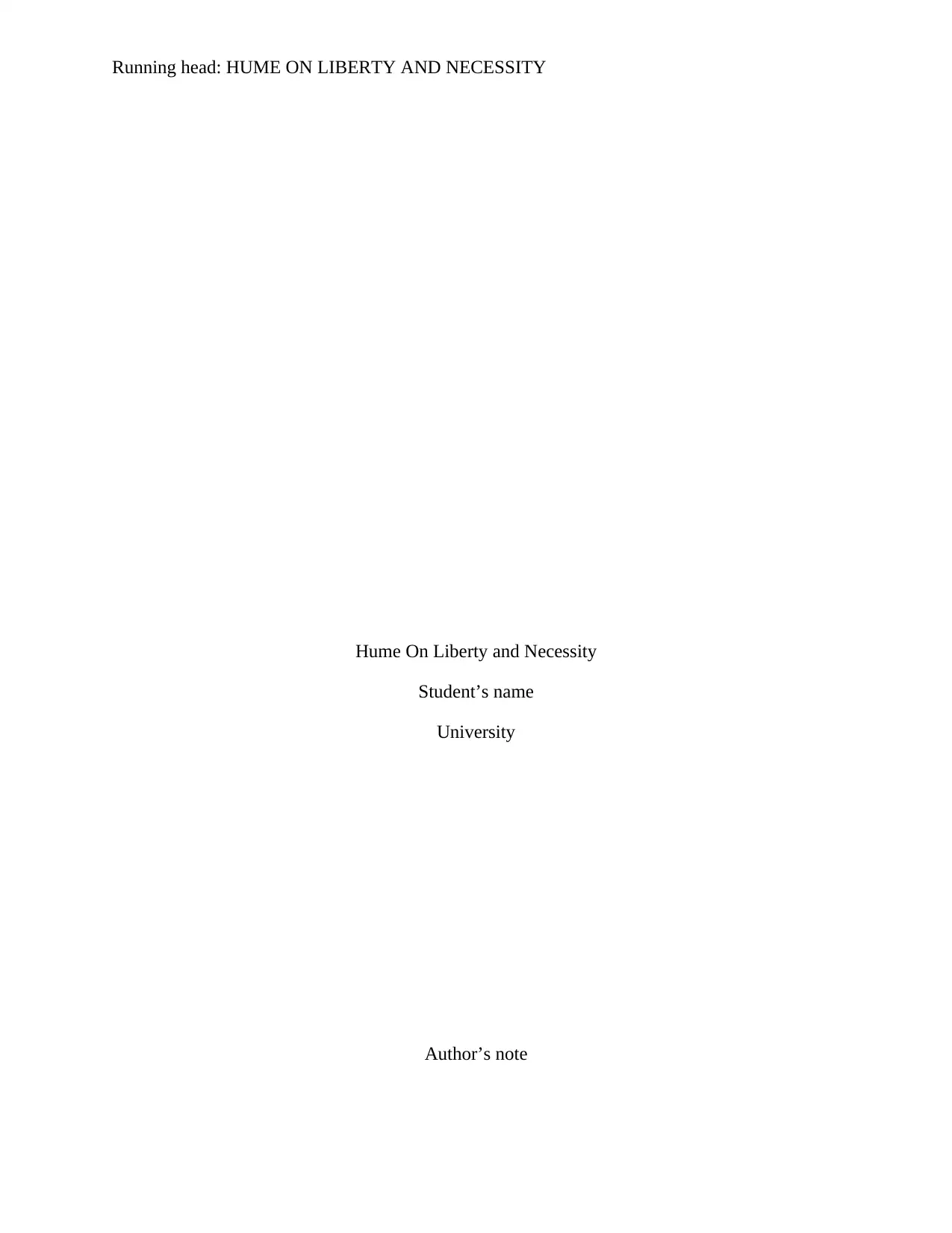
Running head: HUME ON LIBERTY AND NECESSITY
Hume On Liberty and Necessity
Student’s name
University
Author’s note
Hume On Liberty and Necessity
Student’s name
University
Author’s note
Paraphrase This Document
Need a fresh take? Get an instant paraphrase of this document with our AI Paraphraser
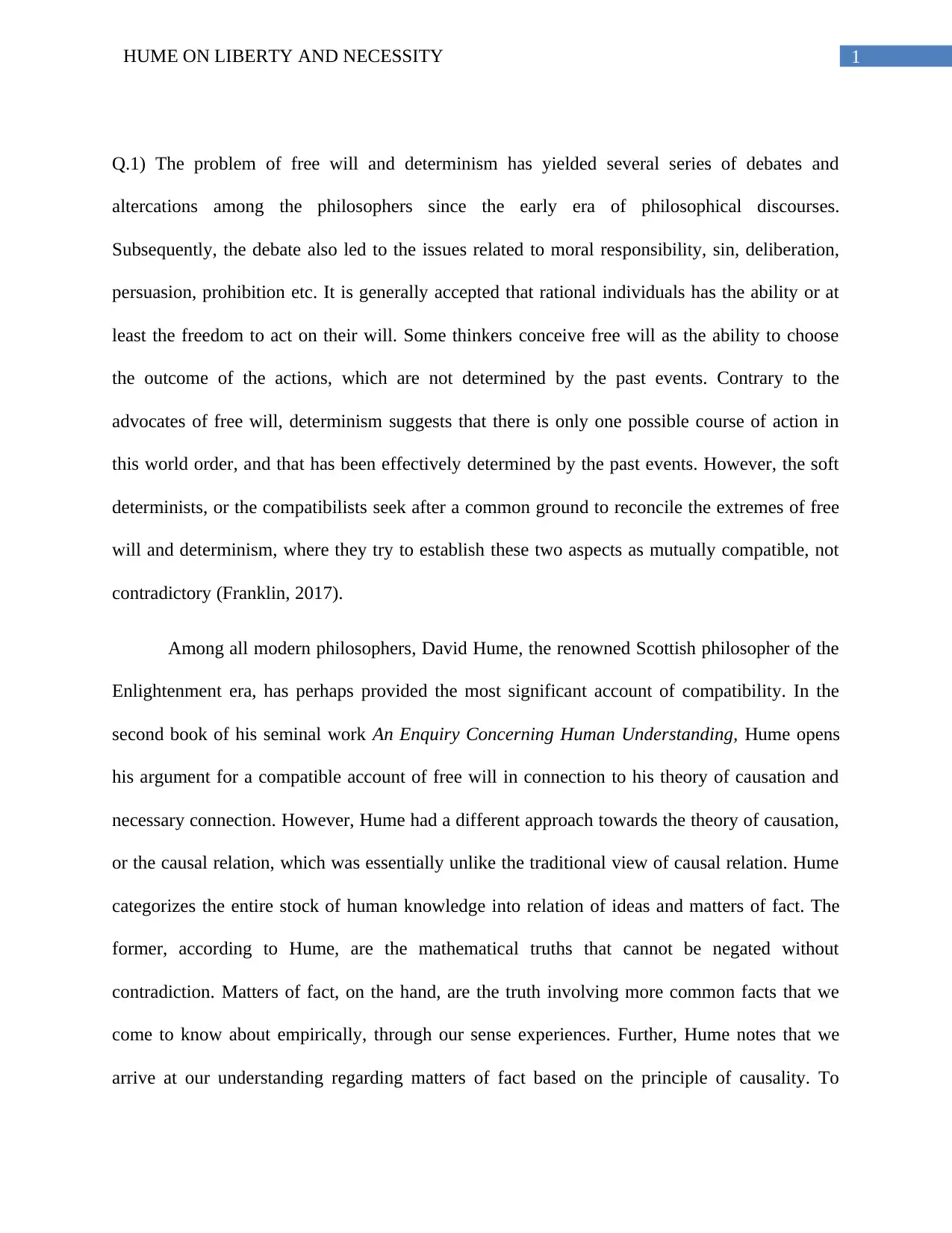
1HUME ON LIBERTY AND NECESSITY
Q.1) The problem of free will and determinism has yielded several series of debates and
altercations among the philosophers since the early era of philosophical discourses.
Subsequently, the debate also led to the issues related to moral responsibility, sin, deliberation,
persuasion, prohibition etc. It is generally accepted that rational individuals has the ability or at
least the freedom to act on their will. Some thinkers conceive free will as the ability to choose
the outcome of the actions, which are not determined by the past events. Contrary to the
advocates of free will, determinism suggests that there is only one possible course of action in
this world order, and that has been effectively determined by the past events. However, the soft
determinists, or the compatibilists seek after a common ground to reconcile the extremes of free
will and determinism, where they try to establish these two aspects as mutually compatible, not
contradictory (Franklin, 2017).
Among all modern philosophers, David Hume, the renowned Scottish philosopher of the
Enlightenment era, has perhaps provided the most significant account of compatibility. In the
second book of his seminal work An Enquiry Concerning Human Understanding, Hume opens
his argument for a compatible account of free will in connection to his theory of causation and
necessary connection. However, Hume had a different approach towards the theory of causation,
or the causal relation, which was essentially unlike the traditional view of causal relation. Hume
categorizes the entire stock of human knowledge into relation of ideas and matters of fact. The
former, according to Hume, are the mathematical truths that cannot be negated without
contradiction. Matters of fact, on the hand, are the truth involving more common facts that we
come to know about empirically, through our sense experiences. Further, Hume notes that we
arrive at our understanding regarding matters of fact based on the principle of causality. To
Q.1) The problem of free will and determinism has yielded several series of debates and
altercations among the philosophers since the early era of philosophical discourses.
Subsequently, the debate also led to the issues related to moral responsibility, sin, deliberation,
persuasion, prohibition etc. It is generally accepted that rational individuals has the ability or at
least the freedom to act on their will. Some thinkers conceive free will as the ability to choose
the outcome of the actions, which are not determined by the past events. Contrary to the
advocates of free will, determinism suggests that there is only one possible course of action in
this world order, and that has been effectively determined by the past events. However, the soft
determinists, or the compatibilists seek after a common ground to reconcile the extremes of free
will and determinism, where they try to establish these two aspects as mutually compatible, not
contradictory (Franklin, 2017).
Among all modern philosophers, David Hume, the renowned Scottish philosopher of the
Enlightenment era, has perhaps provided the most significant account of compatibility. In the
second book of his seminal work An Enquiry Concerning Human Understanding, Hume opens
his argument for a compatible account of free will in connection to his theory of causation and
necessary connection. However, Hume had a different approach towards the theory of causation,
or the causal relation, which was essentially unlike the traditional view of causal relation. Hume
categorizes the entire stock of human knowledge into relation of ideas and matters of fact. The
former, according to Hume, are the mathematical truths that cannot be negated without
contradiction. Matters of fact, on the hand, are the truth involving more common facts that we
come to know about empirically, through our sense experiences. Further, Hume notes that we
arrive at our understanding regarding matters of fact based on the principle of causality. To
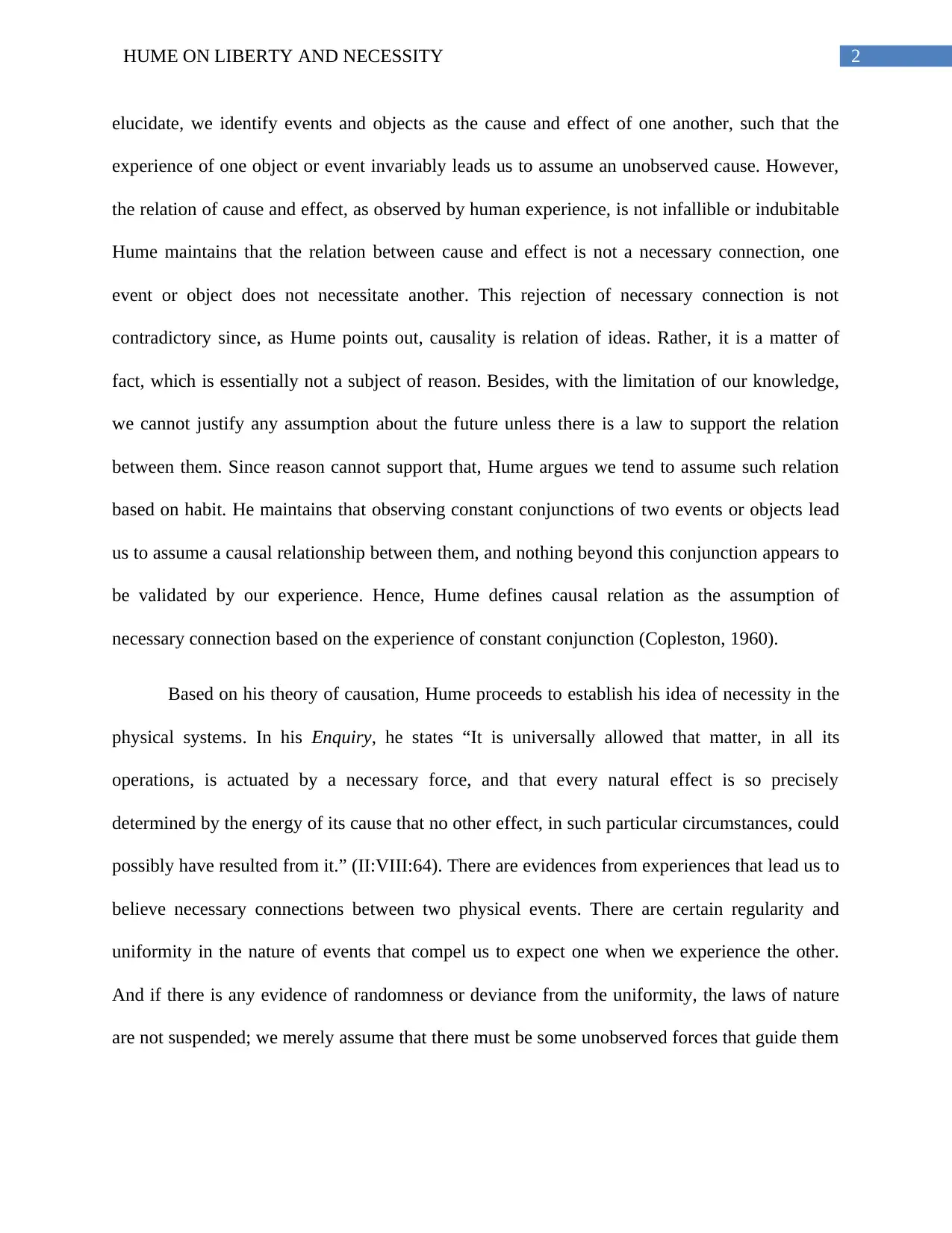
2HUME ON LIBERTY AND NECESSITY
elucidate, we identify events and objects as the cause and effect of one another, such that the
experience of one object or event invariably leads us to assume an unobserved cause. However,
the relation of cause and effect, as observed by human experience, is not infallible or indubitable
Hume maintains that the relation between cause and effect is not a necessary connection, one
event or object does not necessitate another. This rejection of necessary connection is not
contradictory since, as Hume points out, causality is relation of ideas. Rather, it is a matter of
fact, which is essentially not a subject of reason. Besides, with the limitation of our knowledge,
we cannot justify any assumption about the future unless there is a law to support the relation
between them. Since reason cannot support that, Hume argues we tend to assume such relation
based on habit. He maintains that observing constant conjunctions of two events or objects lead
us to assume a causal relationship between them, and nothing beyond this conjunction appears to
be validated by our experience. Hence, Hume defines causal relation as the assumption of
necessary connection based on the experience of constant conjunction (Copleston, 1960).
Based on his theory of causation, Hume proceeds to establish his idea of necessity in the
physical systems. In his Enquiry, he states “It is universally allowed that matter, in all its
operations, is actuated by a necessary force, and that every natural effect is so precisely
determined by the energy of its cause that no other effect, in such particular circumstances, could
possibly have resulted from it.” (II:VIII:64). There are evidences from experiences that lead us to
believe necessary connections between two physical events. There are certain regularity and
uniformity in the nature of events that compel us to expect one when we experience the other.
And if there is any evidence of randomness or deviance from the uniformity, the laws of nature
are not suspended; we merely assume that there must be some unobserved forces that guide them
elucidate, we identify events and objects as the cause and effect of one another, such that the
experience of one object or event invariably leads us to assume an unobserved cause. However,
the relation of cause and effect, as observed by human experience, is not infallible or indubitable
Hume maintains that the relation between cause and effect is not a necessary connection, one
event or object does not necessitate another. This rejection of necessary connection is not
contradictory since, as Hume points out, causality is relation of ideas. Rather, it is a matter of
fact, which is essentially not a subject of reason. Besides, with the limitation of our knowledge,
we cannot justify any assumption about the future unless there is a law to support the relation
between them. Since reason cannot support that, Hume argues we tend to assume such relation
based on habit. He maintains that observing constant conjunctions of two events or objects lead
us to assume a causal relationship between them, and nothing beyond this conjunction appears to
be validated by our experience. Hence, Hume defines causal relation as the assumption of
necessary connection based on the experience of constant conjunction (Copleston, 1960).
Based on his theory of causation, Hume proceeds to establish his idea of necessity in the
physical systems. In his Enquiry, he states “It is universally allowed that matter, in all its
operations, is actuated by a necessary force, and that every natural effect is so precisely
determined by the energy of its cause that no other effect, in such particular circumstances, could
possibly have resulted from it.” (II:VIII:64). There are evidences from experiences that lead us to
believe necessary connections between two physical events. There are certain regularity and
uniformity in the nature of events that compel us to expect one when we experience the other.
And if there is any evidence of randomness or deviance from the uniformity, the laws of nature
are not suspended; we merely assume that there must be some unobserved forces that guide them
⊘ This is a preview!⊘
Do you want full access?
Subscribe today to unlock all pages.

Trusted by 1+ million students worldwide
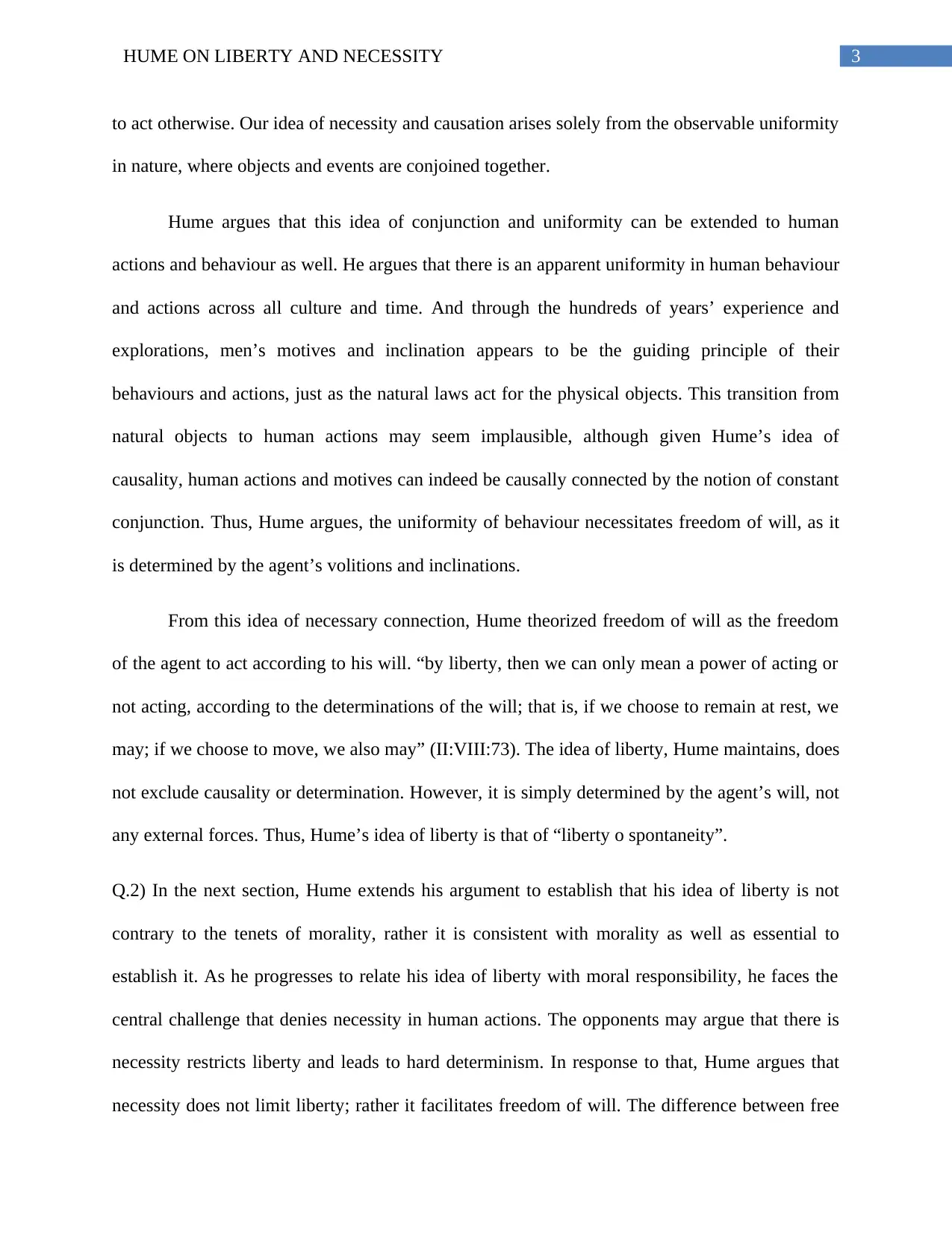
3HUME ON LIBERTY AND NECESSITY
to act otherwise. Our idea of necessity and causation arises solely from the observable uniformity
in nature, where objects and events are conjoined together.
Hume argues that this idea of conjunction and uniformity can be extended to human
actions and behaviour as well. He argues that there is an apparent uniformity in human behaviour
and actions across all culture and time. And through the hundreds of years’ experience and
explorations, men’s motives and inclination appears to be the guiding principle of their
behaviours and actions, just as the natural laws act for the physical objects. This transition from
natural objects to human actions may seem implausible, although given Hume’s idea of
causality, human actions and motives can indeed be causally connected by the notion of constant
conjunction. Thus, Hume argues, the uniformity of behaviour necessitates freedom of will, as it
is determined by the agent’s volitions and inclinations.
From this idea of necessary connection, Hume theorized freedom of will as the freedom
of the agent to act according to his will. “by liberty, then we can only mean a power of acting or
not acting, according to the determinations of the will; that is, if we choose to remain at rest, we
may; if we choose to move, we also may” (II:VIII:73). The idea of liberty, Hume maintains, does
not exclude causality or determination. However, it is simply determined by the agent’s will, not
any external forces. Thus, Hume’s idea of liberty is that of “liberty o spontaneity”.
Q.2) In the next section, Hume extends his argument to establish that his idea of liberty is not
contrary to the tenets of morality, rather it is consistent with morality as well as essential to
establish it. As he progresses to relate his idea of liberty with moral responsibility, he faces the
central challenge that denies necessity in human actions. The opponents may argue that there is
necessity restricts liberty and leads to hard determinism. In response to that, Hume argues that
necessity does not limit liberty; rather it facilitates freedom of will. The difference between free
to act otherwise. Our idea of necessity and causation arises solely from the observable uniformity
in nature, where objects and events are conjoined together.
Hume argues that this idea of conjunction and uniformity can be extended to human
actions and behaviour as well. He argues that there is an apparent uniformity in human behaviour
and actions across all culture and time. And through the hundreds of years’ experience and
explorations, men’s motives and inclination appears to be the guiding principle of their
behaviours and actions, just as the natural laws act for the physical objects. This transition from
natural objects to human actions may seem implausible, although given Hume’s idea of
causality, human actions and motives can indeed be causally connected by the notion of constant
conjunction. Thus, Hume argues, the uniformity of behaviour necessitates freedom of will, as it
is determined by the agent’s volitions and inclinations.
From this idea of necessary connection, Hume theorized freedom of will as the freedom
of the agent to act according to his will. “by liberty, then we can only mean a power of acting or
not acting, according to the determinations of the will; that is, if we choose to remain at rest, we
may; if we choose to move, we also may” (II:VIII:73). The idea of liberty, Hume maintains, does
not exclude causality or determination. However, it is simply determined by the agent’s will, not
any external forces. Thus, Hume’s idea of liberty is that of “liberty o spontaneity”.
Q.2) In the next section, Hume extends his argument to establish that his idea of liberty is not
contrary to the tenets of morality, rather it is consistent with morality as well as essential to
establish it. As he progresses to relate his idea of liberty with moral responsibility, he faces the
central challenge that denies necessity in human actions. The opponents may argue that there is
necessity restricts liberty and leads to hard determinism. In response to that, Hume argues that
necessity does not limit liberty; rather it facilitates freedom of will. The difference between free
Paraphrase This Document
Need a fresh take? Get an instant paraphrase of this document with our AI Paraphraser
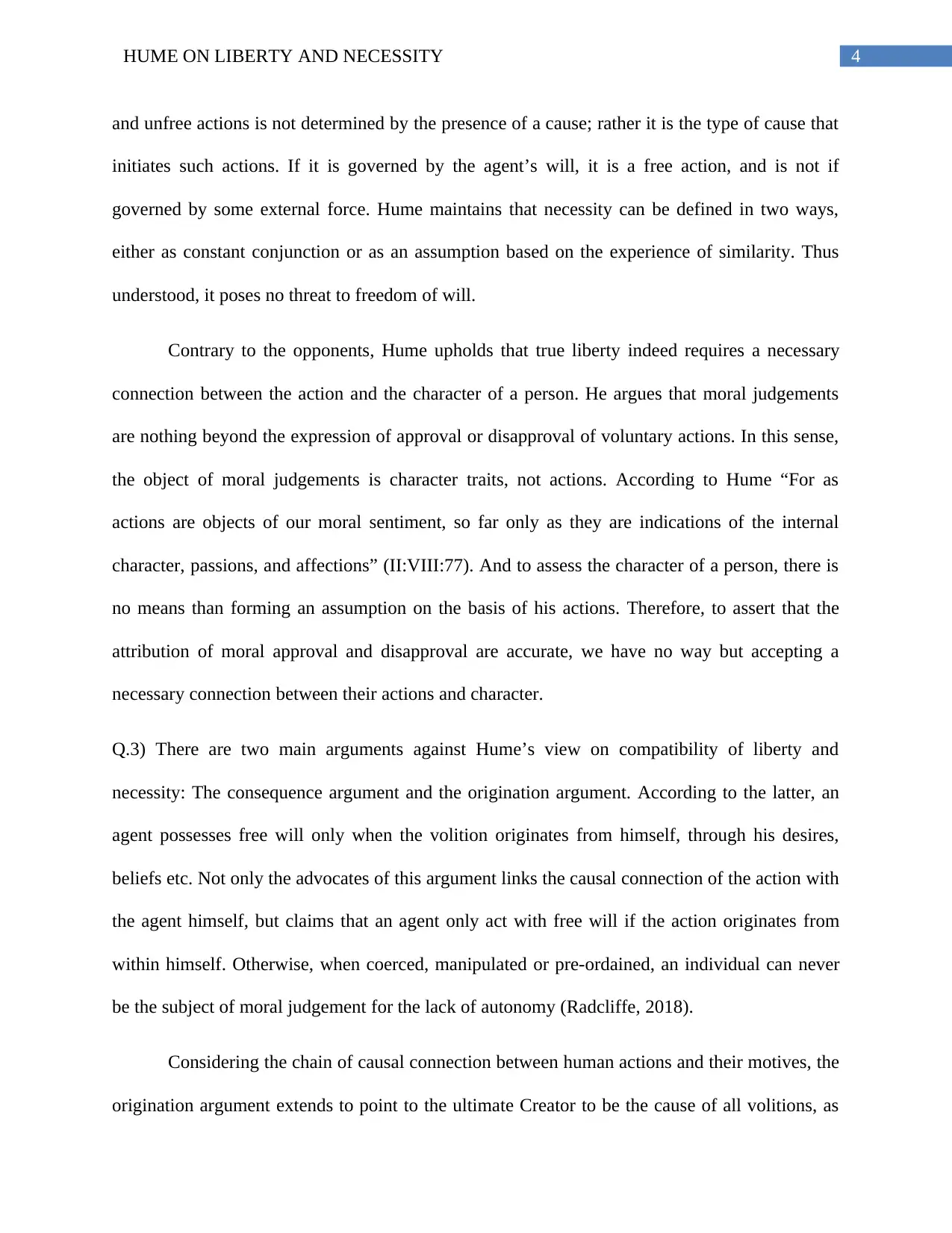
4HUME ON LIBERTY AND NECESSITY
and unfree actions is not determined by the presence of a cause; rather it is the type of cause that
initiates such actions. If it is governed by the agent’s will, it is a free action, and is not if
governed by some external force. Hume maintains that necessity can be defined in two ways,
either as constant conjunction or as an assumption based on the experience of similarity. Thus
understood, it poses no threat to freedom of will.
Contrary to the opponents, Hume upholds that true liberty indeed requires a necessary
connection between the action and the character of a person. He argues that moral judgements
are nothing beyond the expression of approval or disapproval of voluntary actions. In this sense,
the object of moral judgements is character traits, not actions. According to Hume “For as
actions are objects of our moral sentiment, so far only as they are indications of the internal
character, passions, and affections” (II:VIII:77). And to assess the character of a person, there is
no means than forming an assumption on the basis of his actions. Therefore, to assert that the
attribution of moral approval and disapproval are accurate, we have no way but accepting a
necessary connection between their actions and character.
Q.3) There are two main arguments against Hume’s view on compatibility of liberty and
necessity: The consequence argument and the origination argument. According to the latter, an
agent possesses free will only when the volition originates from himself, through his desires,
beliefs etc. Not only the advocates of this argument links the causal connection of the action with
the agent himself, but claims that an agent only act with free will if the action originates from
within himself. Otherwise, when coerced, manipulated or pre-ordained, an individual can never
be the subject of moral judgement for the lack of autonomy (Radcliffe, 2018).
Considering the chain of causal connection between human actions and their motives, the
origination argument extends to point to the ultimate Creator to be the cause of all volitions, as
and unfree actions is not determined by the presence of a cause; rather it is the type of cause that
initiates such actions. If it is governed by the agent’s will, it is a free action, and is not if
governed by some external force. Hume maintains that necessity can be defined in two ways,
either as constant conjunction or as an assumption based on the experience of similarity. Thus
understood, it poses no threat to freedom of will.
Contrary to the opponents, Hume upholds that true liberty indeed requires a necessary
connection between the action and the character of a person. He argues that moral judgements
are nothing beyond the expression of approval or disapproval of voluntary actions. In this sense,
the object of moral judgements is character traits, not actions. According to Hume “For as
actions are objects of our moral sentiment, so far only as they are indications of the internal
character, passions, and affections” (II:VIII:77). And to assess the character of a person, there is
no means than forming an assumption on the basis of his actions. Therefore, to assert that the
attribution of moral approval and disapproval are accurate, we have no way but accepting a
necessary connection between their actions and character.
Q.3) There are two main arguments against Hume’s view on compatibility of liberty and
necessity: The consequence argument and the origination argument. According to the latter, an
agent possesses free will only when the volition originates from himself, through his desires,
beliefs etc. Not only the advocates of this argument links the causal connection of the action with
the agent himself, but claims that an agent only act with free will if the action originates from
within himself. Otherwise, when coerced, manipulated or pre-ordained, an individual can never
be the subject of moral judgement for the lack of autonomy (Radcliffe, 2018).
Considering the chain of causal connection between human actions and their motives, the
origination argument extends to point to the ultimate Creator to be the cause of all volitions, as
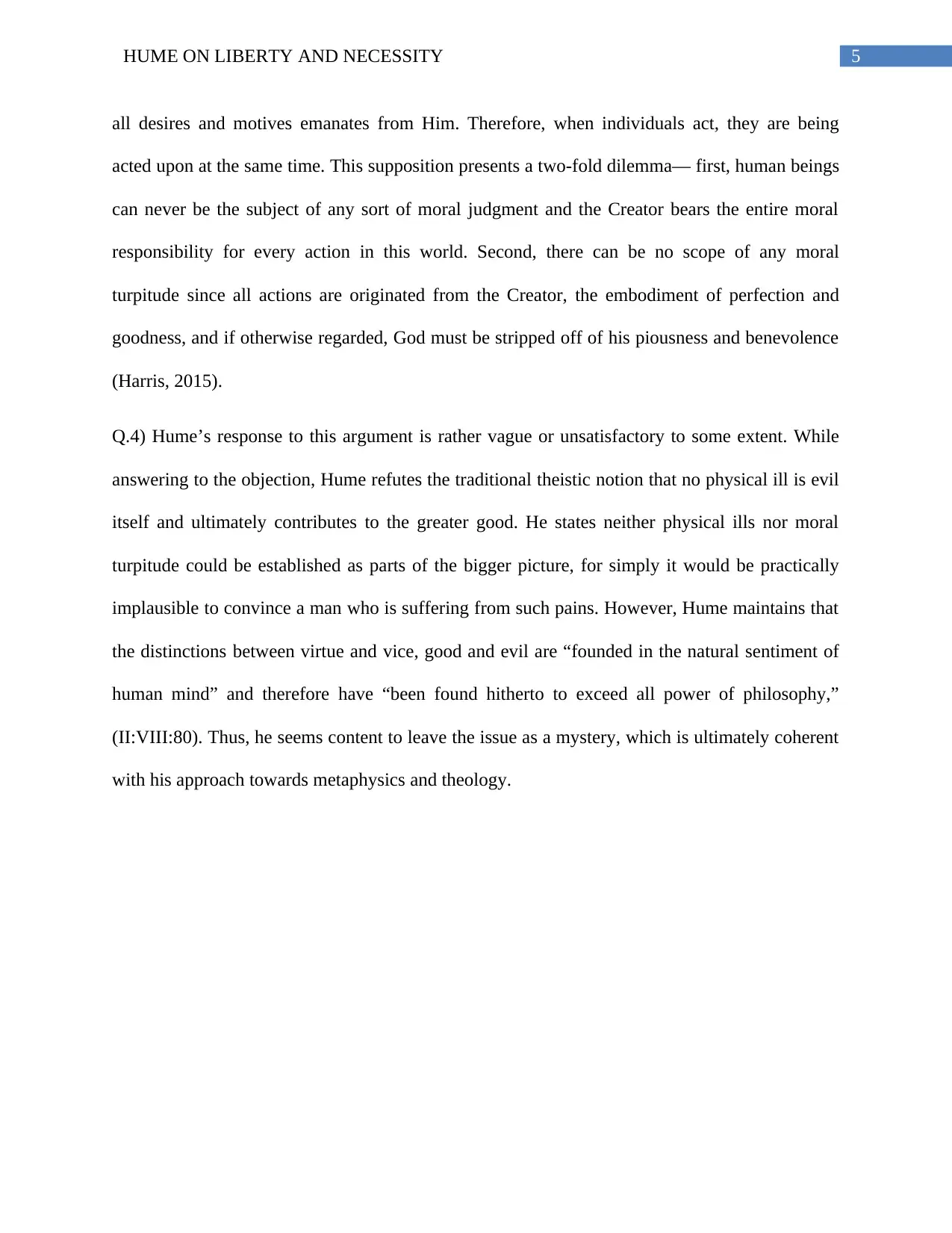
5HUME ON LIBERTY AND NECESSITY
all desires and motives emanates from Him. Therefore, when individuals act, they are being
acted upon at the same time. This supposition presents a two-fold dilemma— first, human beings
can never be the subject of any sort of moral judgment and the Creator bears the entire moral
responsibility for every action in this world. Second, there can be no scope of any moral
turpitude since all actions are originated from the Creator, the embodiment of perfection and
goodness, and if otherwise regarded, God must be stripped off of his piousness and benevolence
(Harris, 2015).
Q.4) Hume’s response to this argument is rather vague or unsatisfactory to some extent. While
answering to the objection, Hume refutes the traditional theistic notion that no physical ill is evil
itself and ultimately contributes to the greater good. He states neither physical ills nor moral
turpitude could be established as parts of the bigger picture, for simply it would be practically
implausible to convince a man who is suffering from such pains. However, Hume maintains that
the distinctions between virtue and vice, good and evil are “founded in the natural sentiment of
human mind” and therefore have “been found hitherto to exceed all power of philosophy,”
(II:VIII:80). Thus, he seems content to leave the issue as a mystery, which is ultimately coherent
with his approach towards metaphysics and theology.
all desires and motives emanates from Him. Therefore, when individuals act, they are being
acted upon at the same time. This supposition presents a two-fold dilemma— first, human beings
can never be the subject of any sort of moral judgment and the Creator bears the entire moral
responsibility for every action in this world. Second, there can be no scope of any moral
turpitude since all actions are originated from the Creator, the embodiment of perfection and
goodness, and if otherwise regarded, God must be stripped off of his piousness and benevolence
(Harris, 2015).
Q.4) Hume’s response to this argument is rather vague or unsatisfactory to some extent. While
answering to the objection, Hume refutes the traditional theistic notion that no physical ill is evil
itself and ultimately contributes to the greater good. He states neither physical ills nor moral
turpitude could be established as parts of the bigger picture, for simply it would be practically
implausible to convince a man who is suffering from such pains. However, Hume maintains that
the distinctions between virtue and vice, good and evil are “founded in the natural sentiment of
human mind” and therefore have “been found hitherto to exceed all power of philosophy,”
(II:VIII:80). Thus, he seems content to leave the issue as a mystery, which is ultimately coherent
with his approach towards metaphysics and theology.
⊘ This is a preview!⊘
Do you want full access?
Subscribe today to unlock all pages.

Trusted by 1+ million students worldwide
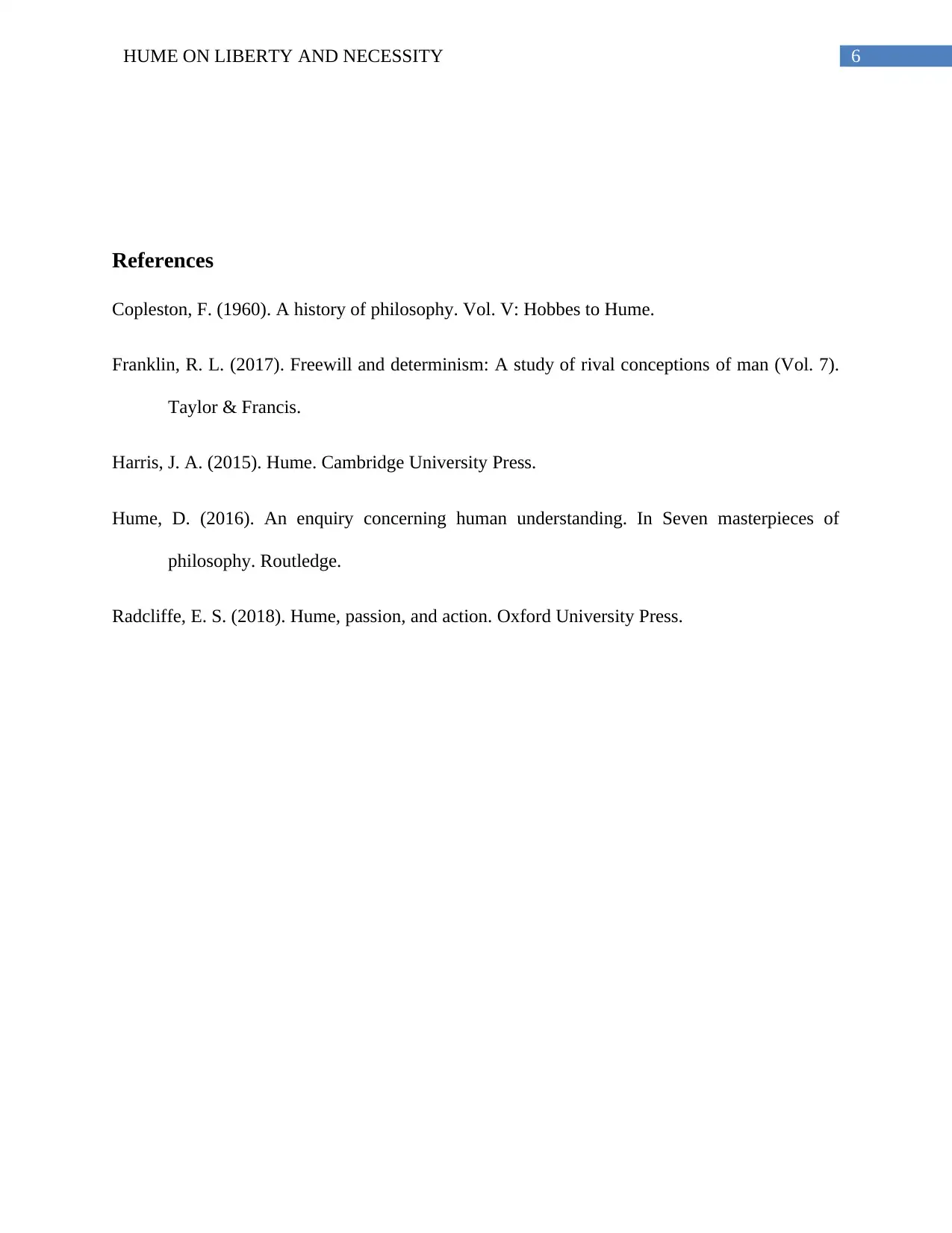
6HUME ON LIBERTY AND NECESSITY
References
Copleston, F. (1960). A history of philosophy. Vol. V: Hobbes to Hume.
Franklin, R. L. (2017). Freewill and determinism: A study of rival conceptions of man (Vol. 7).
Taylor & Francis.
Harris, J. A. (2015). Hume. Cambridge University Press.
Hume, D. (2016). An enquiry concerning human understanding. In Seven masterpieces of
philosophy. Routledge.
Radcliffe, E. S. (2018). Hume, passion, and action. Oxford University Press.
References
Copleston, F. (1960). A history of philosophy. Vol. V: Hobbes to Hume.
Franklin, R. L. (2017). Freewill and determinism: A study of rival conceptions of man (Vol. 7).
Taylor & Francis.
Harris, J. A. (2015). Hume. Cambridge University Press.
Hume, D. (2016). An enquiry concerning human understanding. In Seven masterpieces of
philosophy. Routledge.
Radcliffe, E. S. (2018). Hume, passion, and action. Oxford University Press.
1 out of 7
Your All-in-One AI-Powered Toolkit for Academic Success.
+13062052269
info@desklib.com
Available 24*7 on WhatsApp / Email
![[object Object]](/_next/static/media/star-bottom.7253800d.svg)
Unlock your academic potential
Copyright © 2020–2025 A2Z Services. All Rights Reserved. Developed and managed by ZUCOL.